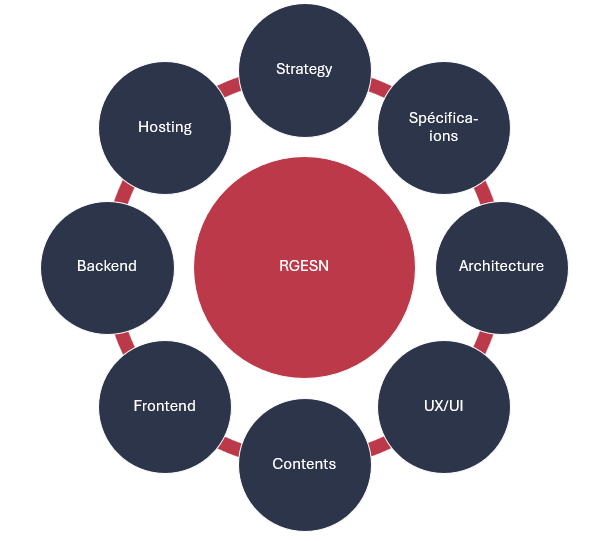The RGESN (Référentiel Général d’Eco-conception des Services Numériques) is a French standard dedicated to eco-design issues..
Just as the RGAA (derived from the WCAG) aims to improve software accessibility, the RGESN’s objective is to reduce the environmental impact of digital services by focusing, at present, on 79 specific criteria.
These criteria are divided into 8 topics:

Each of these themes aims to respond to the specificities of digital services by asking questions that are not necessarily considered when designing software:
- Strategy
The strategy is to take into account the various ecological impacts of the digital service as a whole.
It includes criteria such as:
Has the digital service been favorably evaluated in terms of utility, taking into account its environmental impact?
This criterion highlights the importance of considering environmental impacts from the moment we start thinking about building the service.
Can the digital service be used on terminals aged 5 years or more?
This criterion is there to remind us that the main impact of digital services is on hardware and the construction of materials. Having a service that works on old terminals means you don’t have to renew them.
Has the digital service identified indicators to measure its environmental impact?
You can’t improve what you don’t measure! Environmental impacts must be improved and therefore measured with indicators.
- Specifications
The specifications take into account the various ecological impacts of the digital service right from the design stage.
It includes criteria such as:
Has the digital service been designed with a design review and a code review, with one of the objectives being to reduce the environmental impact of each feature?
Reviews are one of the most effective ways of preventing defects. It is essential to review specifications. Defects can be linked to negative environmental impacts, so it’s important to incorporate checks on the subject.
Has the digital service taken into account the environmental impact of the third-party services used when selecting them?
A digital service is not isolated. It generally uses third-party services. Its impact is therefore not limited to itself, but extends to its partners. It’s important to bear this in mind when selecting third-party services, as well as partners and suppliers.
- Architecture
Architecture is the consideration of the various ecological impacts of the digital service adapted to the use and evolution of the software.
It includes criteria such as:
Does the digital service operate on an architecture that can adapt the amount of resources used according to service consumption?
An architecture must be able to handle peak loads. But these load “peaks”, as their name suggests, are peaks. It is not necessary to be able to absorb them at all times. An architecture must be capable of adapting to needs in order to consume its resources efficiently.
Does the digital service use an exchange protocol adapted to the content transferred?
Depending on the content to be transferred, protocols are more or less efficient from an environmental impact point of view. This must be taken into account in the architecture.
- UX/UI
UX/UI means taking into account the various ecological impacts of digital services through their day-to-day use.
It includes criteria such as:
Can the digital service be used over a low-speed connection?
Not everyone has access to a good connection. Offering a service that works with a low-speed connection means offering a service that requires few resources and therefore has a limited negative environmental impact.
An image takes up much more space than text. Similarly, a video takes up much more space than an image. Every time you use a video, ask yourself whether it can be replaced by an image… And for every image, ask yourself whether it can be replaced by text.
- Contents
Contents are the consideration of the various ecological impacts of the digital service through its mode of use.
It includes criteria such as:
Does the digital service use a file format adapted to the content and viewing context of each image?
To limit its impact, it’s extremely important to offer content that adapts to the context. There’s no point in having 4K on HD images or videos when you’re watching videos on a phone.
Does the digital service have a strategy for automatic or manual archiving and deletion of obsolete or out-of-date content?
Storage has an impact on the environment. There’s no point in “keeping” obsolete content, so it’s important to remember to delete it regularly to avoid unnecessary consumption.
- Frontend
The frontend takes into account the various ecological impacts of the digital service by limiting the consumption of graphic interfaces.
It includes criteria such as:
Does the digital service impose a limit on the number of requests per screen?
Requests place a heavy load on servers and are one of the most significant factors in the resource consumption of digital services, as can be seen from the ecoindex. It is important to limit them in order to minimize the impact of digital services.
Is the digital service limited to loading the components used in the libraries where possible?
What’s the point of spending resources if it doesn’t make sense? It’s important to load only what’s necessary. This applies not only to digital service content, but also to library components.
- Backend
The backend is the consideration of the various ecological impacts of the digital service through the limitation of storage and API consumption.
It includes criteria such as:
Is the digital service configured to transmit compressed content from the server to the client, who accepts it?
Compressed content takes up less space. It is therefore less costly to transfer them in this way to limit environmental impact.
Does the digital service define retention periods for the data and documents that require them?
The less space used, the less resources consumed. To limit the space taken up by data, you can delete data. But you can only delete data if you’re sure it’s out of date. The addition of retention periods is the answer to this.
- Hosting
Hosting is taking into account the various ecological impacts of digital services by limiting server consumption.
It includes criteria such as:
Does the digital service use hosting that provides a sustainable equipment management policy?
The greatest environmental impact of digital services is on hardware. Preserving equipment, and therefore managing it sustainably, considerably reduces the ecological impact of digital services.
Does the digital service use hosting whose geographical location is consistent with that of its users and activities?
Having servers close to users reduces the distance required for data and information transmission. This reduces the environmental impact (and response time) of the digital service.
Conclusion
The environmental impact of digital services is now a systemic issue, and needs to be considered at every stage in the life of a digital service.
The RGESN addresses these issues through the analysis of best practices in digital service eco-design. It enables companies to define a strategy for reducing the environmental impact of their digital services, as part of a more global GreenIT approach.
The RGESN obviously has its limits, and it’s important to make the most of it to design improvements that will take things even further. That’s what we’ve done, and what we’ll be presenting to you in a future article on this blog.

Marc Hage Chahine
QA Practice Manager
www.k-lagan.com
+34 93 535 1500
info@k-lagan.com



